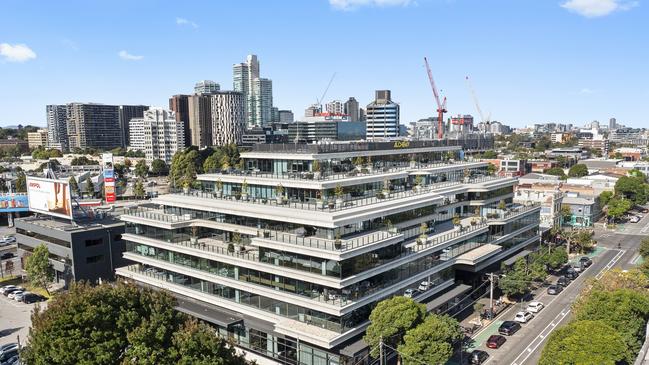Back to work: landlords see return to desks
Big corporations that allowed staff WFH flexibility are now reversing the policy, in a move that has implications for landlords in the city and suburbs.

Corporate Australia is making the big shift back to work, with large companies and landlords calling out the need to bring staff together in order to boost flagging productivity and competitiveness.
In the new order emerging at work, hybrid working styles have won acceptance from local and multinational corporations, but business is now calling staff back to offices for at least part of the week, as an economic slowdown and job cuts loom.
The shift has wide-ranging implications for landlords in city and suburban locations as employees speed their return and major companies devise longer-term leasing strategies.
The move has generated some conflict, with staff wedded to working-from-home practices which developed during the pandemic. But corporate leaders have argued that a move back to the office is essential.
The big banks, which carry sway as anchor tenants of a swath of city and suburban space, have emerged as leaders in wanting staff back in offices, with the Commonwealth Bank ordering a return to the office at least 50 per cent of the time despite copping a pushback.
In April, NAB chief executive Ross McEwan brought his senior leaders back to the office five days a week.
And the influential superannuation sector is also taking a lead, with Hostplus CEO David Elia warning that companies cannot build a competitive advantage if they prioritise work-from-home demands over workplace culture.
The fund’s senior executives are back in the office four days a week.
This top echelon of executives are also focused on realising the benefits of being in the office across their organisations.
JLL’s global Future of Work Survey found that 72 per cent of decision-makers believe the office is critical to doing business, and 45 per cent consider collaboration to be one of the primary purposes of office space.
“Productivity and innovation are now a big focus for organisations in 2023 as more evidence emerges that the disrupted working patterns from the pandemic have had a big impact on both,” said Dan Kernaghan, JLL CEO for Australia and New Zealand.
“We see a clear link between innovation within companies and collaboration in the workplace,” Mr Kernaghan said.
“If you look at patent statistics as a measure of innovation, we can see some clear patterns that have emerged from the pandemic.
“It has been reported that provisional patent filings in Australia are at the lowest level since the mid-1980s, and that US patents declined through the Covid period.”

There has been a marked shift in companies in Australia that are requiring employees to come back to the office for at least part of the week.
Insights garnered by major real estate agencies that manage buildings have identified big tech players such as Amazon, Apple and Google as bringing back staff, generally for around three days a week.
Many financial services companies, such as AMP and Macquarie Group, are also back about three days a week, with deal teams in more frequently, they reported.
Professional services firms including Deloitte, EY, KPMG and PwC tend to do three office days per week, with flexibility for time spent at clients’ offices, agencies said.
Resources firms such as BHP, Rio Tinto, Santos and Shell tend to be at the lower end of the scale, agents said, with some adopting two days a week in offices. But executives also spend time on worksites.
Big corporate tenants such as telco Optus and tech giants Microsoft and IBM have policies which usually see staff in two to three days a week, agents reported.
Landlords are also seeing the shift – and say it is translating to greater demand for space.
Centuria Capital, which manages about $7.5bn of offices around Australia, said its latest office tenant survey revealed encouraging occupant trends. More than 75 per cent of respondents expected to retain or increase their office space requirements in the medium term.
Tenants had also considerably pulled back on their working-from-home arrangements. Only 18 per cent of respondents now had fully flexible working conditions, well down from 32 per cent a year ago.
Centuria said this indicated a strong return to office work culture and rising physical occupancy, which could counter concerns about continuous leasing decline and physical occupancy resulting from working-from-home dependency.
“The survey results reaffirm what our property and asset managers have reported anecdotally – that building occupancy is increasing and leasing demand is on the rise across a number of Australian office markets outside the Sydney and Melbourne CBDs,” Centuria joint CEO Jason Huljich said.

In the listed pure-play office fund, Centuria Office REIT, more than 155,000sq m has been leased across the 23-building portfolio since 2020, when the pandemic routed the sector.
Leasing activity has since jumped, and higher costs are prompting some tenants to stay put in their spaces.
“Inflation’s impact on interest rates has a knock-on effect for construction costs, not only concerning new building developments but office fit-outs,” Centuria head of office Grant Nichols said.
“New fit-outs are an upfront expense and one that can be further hindered by potential delays due to labour shortages.”
The shift back to office is also coming after a three-year experiment in being at home, which landlords believe has ultimately failed.
“There’s no doubt that a lot of organisations, both government and corporate, realise that the working-from-home model doesn’t work,” Charter Hall CEO David Harrison said.
The property chief, whose firm manages an office portfolio topping $30bn, says there is a tolerance for hybrid working.
“But I think, in the main, we’re on a trajectory where most corporates are going to expect their people back in the office,” he said.

Mr Harrison cited the lack of collaboration, risk management, and the culture that arises from having a detached workforce. There are also concerns emerging about more profound changes.
“Be careful what you wish for. If organisations can replace people with AI for processing and those sorts of roles, they’ll go down that route,” he said. Mr Harrison said the inconvenience of commuting must be weighed against the “cultural destruction” that was hitting a younger generation starting work, who were deprived of training and mentoring.
He sees major corporations now making longer-term decisions, with less density per person and more amenity to draw back staff, who want more than just their offices back.
“It’s also creating a re-centralisation of demand back into CBDs where all the hospitality and services and retail and transport exists,” Mr Harrison said.
“There’s a growing acceptance from both multinational and national organisations that they’re going to do their very best to create a work environment that gets people back in the office,” he said.
In the words of the property chief, “it’s going to be a journey”. And landlords, tenants and staff best be ready.




To join the conversation, please log in. Don't have an account? Register
Join the conversation, you are commenting as Logout